Worldcon Wayback Machine Introduction: Thirty years ago this weekend ConFrancisco, the 1993 World Science Fiction Convention, was held in San Francisco, California. I thought it would fun to compile a day-by-day recreation drawing on the report I ran in File 770, Evelyn Leeper’s con report on Fanac.org (used with permission), and the contributions of others. Here is the second daily installment.
The Worldcon was held in the Moscone Convention Center, ANA Hotel, Parc Fifty Five, and Nikko Hotel.
[Mike Glyer] Friday in the Parc with Norton: The scourge of homelessness being on everyone’s mind it became unintentionally appropriate that an actor spent the weekend playing San Francisco’s celebrated wanderer, Emperor Norton. The original roamed 19th century San Francisco’s streets with his dogs Bummer and Lazarus.
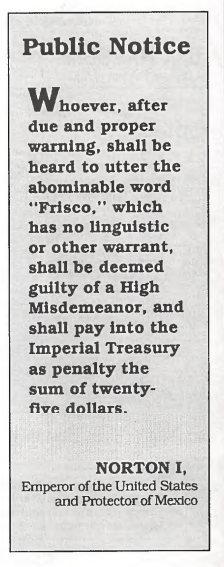
The regally costumed impostor participated in Opening and Closing Ceremonies, cut the ribbon to officially open Hall D, attended the Hogu Ranquet, and convened ConFrancisco’s version of the meet-the-pros on Friday night at the Parc 55 Hotel. He decreed, “His Imperial Majesty, Norton I, Emperor of the United States and Protector of Mexico invites all his loyal subjects — and all the disloyal ones as well — to the Imperial Reception in honor of ConFrancisco’s Honored Guests and Hugo and Campbell nominees.”
Norton’s party belied the proverb that there is no such thing as a free lunch. Science Fiction Age donated a huge cake. Other free snacks included a freeze-dried “ice cream of the future,” and someone who’d had several servings drank up everything in sight at the LA party, warning that the ice-cream of the future sucked liquid out him equal to its weight.
Reception organizer Eve Ackerman, the power behind the throne, credited Glasgow ’95 Worldcon committee for making the evening by staging a ceilidh, a Celtic dance party.
[Mike Glyer] The Hall D Concourse: ConFrancisco’s Concourse, simply called Hall D, worked very well. If the committee did not devise anything like MagiCon’s golf course to systematically lure people through the exhibits, their creativity shone through in other ways.
Two visual signatures energized the ordinarily dead space above Hall D. A colorful balloon sculpture of a 20-foot-long Chinese dragon strutted midair. A second balloon sculpture, all gray and meant to symbolize a bridge, hung at the back of the hall. The bridge was less successful, merely looking like a garland until viewed end-on, when the cross-braces became visible.
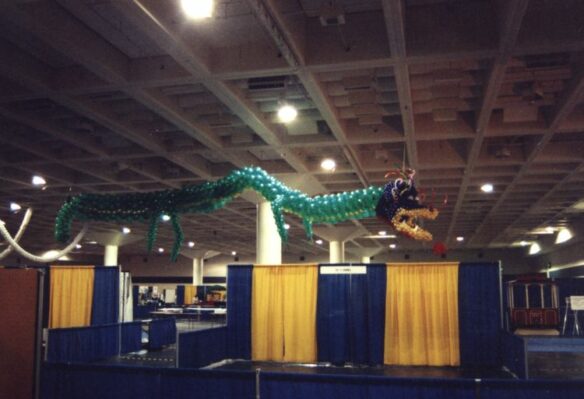

Hall D’s layout was roughly like a rectangle divided into six blocks. The blocks contained, in clockwise order starting from the upper left, (1) Historical exhibits; (2) Local color exhibits; (3) & (4) the Dealer’s Room; (5) sales, volunteers, bid tables and the fan lounge; (6) the Art Show.
Gary Louie did his usual outstanding job with the Hugo Awards exhibit, showing Hugos won by Kelly Freas, Robert Silverberg and others, and copies of award-winning novels. Gary also had his hand in the guest of honor exhibits. Did you notice two bogus items in the Larry Niven display, Niven’s Hollywood (by that other Niven), and The Hindmost, a non-sf book coincidentally named the same as the Puppeteer leader?
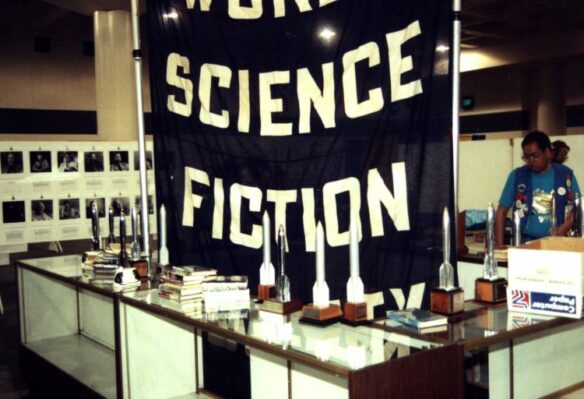
The Local Color exhibit had an appealingly cryptic geography. One day the newzine invited readers to find the exhibit “at the SF Abridged area, just this side of the Doggie Diner head, near the corner of El Camino Real and Emperor Norton Boulevard.” It’s quite possible everyone immediately understood the directions since they referred to the eight-foot-tall, torsoless head of that papier-mache hound from heck, M. Barkadero. His day job is advertising The Doggie Diner. He spent the weekend at ConFrancisco overseeing exhibits about the Bay Area: rock concert art from the Fillmore Presents collection, a government display about quakes, and vibrators from the Good Vibrations museum.
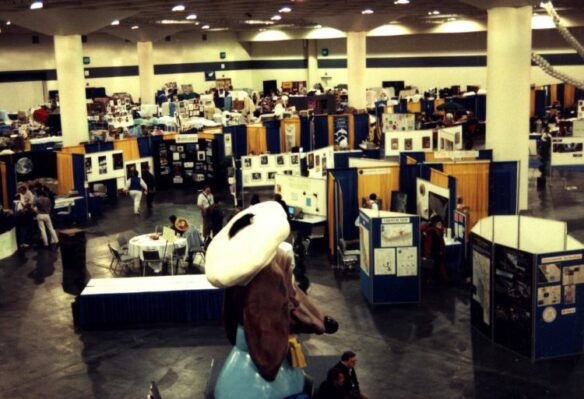

Just one block (or carpet square) away was the Speaker’s Corner, offering passing fans a platform where they could try and attract an audience for whatever was on their minds. Fanzine fans borrowed it Saturday afternoon to perform Andy Hooper’s latest faanish movie parody, The Last Ghurrah. Hooper was a riot in the Spencer Tracy role of a fan political hack at the end of his career, helped by a dozen players including Jeff Schalles and Jerry Kaufman.
Hooper also organized the Fan Lounge adjacent to the Local Color area. The Lounge was an oasis made of pipe and drape, opening onto an area containing eight round tables where customers of the espresso bar munched on muffins and foot-weary passersby alighted to rest and study the Quick Reference Guide. Andy Hooper supervised fanzine sales, and gave the evil eye to the overflow breakfast crowd poaching seats in his Lounge. The owner of the espresso concession complained how little business he was doing after I commented about the new plastic antennae he sprouted on the con’s second day, his own attempt at “local color.” I didn’t have a chance to ask him how business went the rest of the weekend because I couldn’t get through the line around his stand.
The refreshment area served a valuable purpose as someplace people could run into friends, because it was beside the heavily-traveled intersection of two paths leading to the Dealer’s Room or the Art Show.
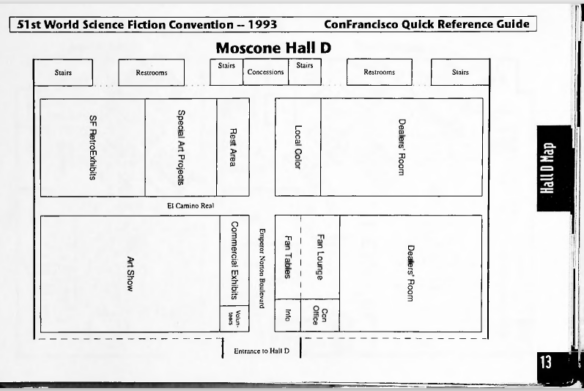
[Evelyn C. Leeper] Panel: Ahoy, Have You Seen the Great White Archetype? (Friday, 12 noon) [Panelists] Mary J. Caraker, Howard Frank, Katharine Kerr (m), Mike Resnick, Carol Severance. [Topic] “What are they? Uses and abuses? Are there ‘styles’ in archetypes over the years?”
The panel described archetypes as “ripping off mythological themes,” as well as Christ figures and primitive legends. Most science fiction and fantasy is dominated by white European cultures and archetypes, though Severance uses Pacific Islanders and their archetypes. (Severance did note that she realizes that “Pacific Islanders” is a very broad term, encompassing many different cultures.) Severance felt that using different cultures made the fiction more interesting, because “every culture carries the rhythm of the physical setting that it’s in.” She mentioned in passing the large number of words for snow in Inuit languages, but also said that every Pacific Island language had a word meaning “death by falling cocoanut.” Caraker is using the Kalevala (Finnish)–European, but not really over-used.
The panelists tried to distinguish between stereotype and archetype by saying the an archetype is a function within a pattern of story (e.g., quest stories have a hero). As Maia Cowan noted, archetypes don’t have to be people; they can be the quest itself, the journey, the generational ship, the wild place, or the clean village. (Someone noted that Earth is a generational ship, and someone else observed only poor villages were clean, because only rich villages would have garbage.) Olaf Stapledon was an author with a lot of archetypes and no characters whatsoever.
One danger in talking about archetypes is that people will find things in writing that was never (consciously) intended by the author.
H. Rider Haggard was an author cited whose work was almost entirely archetypal. But Frank noted that Haggard’s best-known work was not his best, and that Haggard had the utmost respect for black culture in Africa, contrary to many people’s impressions. Haggard also has a Victorian view of women but not, Frank claimed, a negative one. (Frank recommended Nada the Lily and Eric Brighteyes as Haggard’s best. She was written in six weeks on a bet.)
Doyle used archetypes: the wise old storyteller in Watson (and others). In fact, the wise old storyteller is a very popular archetype among authors, undoubtedly because they are storytellers. Wells has his wise old professor (Cavor). Romulus and Remus are the feral children, which we see later in Rudyard Kipling’s Mowgli and Edgar Rice Burroughs’s Tarzan. But now these characters are usually given some flaw, usually for comic effect. Even so, science fiction still has noble characters, according to Frank, while most literature doesn’t. Kerr felt that women authors often play against archetype as well as against stereotype in their female characters.
We now have the wise and compassionate alien and the creation that destroys its creator. They may seem new, but they really go back to the angel and the golem. There’s also the master navigator, which shows up with Maoris as space-farers. And Heinlein’s “competent man” is another archetype.
Someone asked if archetypes are what prevents science fiction from becoming a literary artform, or at least accepted as literature. This seems unlikely; there is much archetypal literature that is accepted as literature.
Anti-heroes are also found in science fiction: Alfred Bester’s Demolished Man and The Stars My Destination, Clifford Simak’s City, and David Lindsay’s Voyage to Arcturus. The prophet as archetype is now often replaced by the author himself or herself, as when someone writes an “if this goes on?” tale. This observation led someone to wonder if a Calvinist (or other believer in predestination) could accept a cautionary tale. On the other hand, what are all the warnings of damnation in the Bible if not cautionary tales?
Apropos of not much else, someone noted that in 1966 a survey of science fiction authors was taken and only Robert Heinlein and Robert Silverberg were making more than $10,000 a year from their science fiction writing. (Isaac Asimov was making more, but mostly from his science writing.) Things have improved; a recent survey shows several authors (unnamed) making more than $50,000 a year from their science fiction writing.
[Mike Glyer] Panel: Professional Ethics for the Amateur (Friday 1:00 PM) [Panelists:] David G Hartwell (m), Teddy Harvia, Rachel E Holmen. [Topic:] “Artists, writers & editors: being professional- even if you’re not paid.”
Editors David Hartwell and Rachel Holmen, and artist Teddy Harvia addressed the topic from two viewpoints, how amateurs should interact with editors for the benefit of their future in the business, and how fans should function ethically within the realm of fannish publishing.
Hartwell began by admitting amateurs’ manuscripts are held to a higher standard of simple neatness, because if Heinlein or Delany submit sloppy manuscripts — as Delany may, due to his dyslexia — the editors already know they want to read the stories very carefully.
Rachel Holmen said that simultaneous submission of stories to several publishers can cause a real headache because amateurs don’t know the rules. Foremost, the writer must tell a publisher they are receiving a simultaneous submission. This avoids a real nightmare of having an editor, who has already sent a manuscript to press, discovering the same story in another magazine on the stands.
Teddy Harvia warned against unethical fanzine practices. He’s seen it all, in his 15 years as a fanartist. When a faned traced one of his cartoons onto mimeo stencil, Teddy considered it a misrepresentation of his art and refused to let the fan publish any of the others Teddy had submitted. The fan replied that he had the cartoons, he had the rights to them, and would do as he pleased. In an unusual move, Harvia engaged a lawyer to write a letter to the fan demanding attorney fees and a fine of $50. Apparently he scared the hell out of the kid, who sent the money.
[Evelyn C. Leeper] Panel: Gender Bending: What’s Good (Friday, 2:00 PM) [Panelists:] Michael Blumlein, Suzy McKee Charnas, Jeanne Gomoll (m) [Topic:] “Exploration of gender and roles isn’t as popular in science fiction as it used to be. Are the issues too imponderable or have we explored this area thoroughly?”
Blumlein started out by reminding us that the major debate about gender roles is still nature versus nurture. One of the best examples using the nurture theory in recent books is Sheri Tepper’s Sideshow, in which the one of the two (hermaphroditic) halves of a set of joined twins is raised as a boy and one is raised as a girl.
Charnas noted that women can fill the spectrum of behavior, but that most fiction doesn’t provide enough templates for this. However, if one writes about a society composed only of women, one finds that there is no problem in writing about a complete society. One doesn’t find parts that women can’t fit. (One assumes the same would be true from a men-only society, assuming some form of artificial reproduction. In fact, someone said that Lois McMaster Bujold did this with Ethan of Athos.)
One function of gender roles is to provide people with an anchor of stability. Most people are uncomfortable in free-floating masses of people (according to Charnas) and so groups form. (This hearkens back to Robinson’s comments about tribalism in his Postmodernism lecture.) Charnas gave Nicola Griffith’s Ammonite as a good example of this group dynamic. The discussion drifted into “gender dysphoria,” or the psychological condition of feeling that your psychological sex doesn’t match your physiological sex. (Forgive me if I am expressing this poorly; I do not have an M.D.) Someone said that, while transsexual surgery used to be considered a solution to this, such surgery is becoming less popular, though many people are taking the necessary hormones and living as the “other” sex. One suggested reason for this is that the easier of the two surgeries is male-to-female, but being a female in society today results in a loss of power, and people aren’t ready to do that permanently. (Though I would think living as a female would have the same effect.) With this, as with a lot of the discussion, a lot of generalizations were thrown around.
Someone pointed out that even if someone did change their sex later in life (such as happened in Virginia Woolf’s Orlando), they would still have experienced the first part of their life as their original sex. In the case of Orlando, he had gone through adolescence as a boy, and so did not have the same life experiences as someone who went through adolescence as a girl, even after he changed into a woman. (The panelists felt that the movie left a lot out that the book had.)
Regarding gender roles, someone observed that society makes rules because the rules aren’t fixed within us–if they were, we wouldn’t have to make artificial ones. Someone else cited The Rainbow Man by M. J. Engh, in which women were defined as people who could give birth. So a “woman” who had some physiological problem which would prevent her from giving birth would not be considered a woman by that society.
One belief expressed was that there is a lot of emphasis placed on the societal pressures put on girls and woman, and less placed on the corresponding pressures on boys and men. At least one panelist said that we pretend that we can “skip the angry part” of problem-solving, but that is not true; we need to confront the pain.
There was some book-flogging at the beginning of this panel. Blumlein, who has an M. D., has written The Movement of Mountains and The Brains of Rats, and has a new book (called X, Y) coming out soon from Dell which will deal with a gay man who wakes up one day as a woman.
[Note: When discussing this subject, one trips all over the pronouns of the English language. If one is discussing someone who is in transition from one sex to the other (or was one and is now the other), pick either “he” or “she” and stick with it. “He/she” may work in written language as a replacement for “He or she,” but in spoken language “he-she” is considered as offensive as any number of racial or ethnic epithets which I will not list here. This is undoubtedly because this grammatical construction has been picked up by the religious right and used by them in an extremely negative and condescending fashion. So now you know.]
[Evelyn C. Leeper] Panel: Turning the Wheels of If (Friday, 6:00 PM) [Panelists:] Charles K. Bradley, John L. Flynn, Evelyn Leeper (m), Brad Linaweaver, Paul J. McAuley. [Topic] “A discussion of likely change points for alternate realities, universes and histories”
[Much thanks to Mark [Leeper] for taking copious notes during this panel, as I can’t be on a panel and take notes at the same time.]
Although usually the panelists for a topic are authors who have written about that topic (and that was true here of Flynn, Linaweaver, and McAuley), Bradley was on the panel for a more unusual reason: he uses alternate history as a way to teach students regular history (though he did admit that sometimes he had to make sure they weren’t getting confused about what was real and what was imaginary!).
I started by asking the panelists to pick one change point they would like to see dealt with, with the caveat that it not be European or North American, and especially not the American Civil War or World War II. McAuley thought that something involving Chinese expansionism might be good, although the feeling was that the Chinese philosophy did not lend itself to exploration; the Chinese had more of a feeling that other people should come to them. I suggested that if this came out of Confucianism, then a timeline without Confucius might have some interesting results. (Someone later suggested that the Chinese stopped exploring because they saw no monetary benefit from continuing.) Flynn said the one alternate history story he had written (“Paradox Lost”) assumed that the Library at Alexandria hadn’t been burnt and that the Egyptians conquered the world. I pointed out that what Mark was always reminding people was that the amount of time since the fall of the Egyptian empire was shorter than the time the empire existed (or as Mark says, “We are in the umbra of the Egyptian empire”). Linaweaver said he had just written “The Bison Riders” in which the Aztecs are not defeated by the Spanish, but instead become high-tech and expand into North America. (Strictly speaking, this is still a North American change point, but not a Eurocentric one.)
Bradley thought that something interesting could be done with General William Walker, who tried to seize Baja California and Sonora in 1853. He failed, but set himself up as president of Nicaragua in 1856, but was expelled in 1857. In 1860, he invaded in Honduras, where his luck ran out: he was captured, court-martialed, and shot. Even today, he is hated by many factions in Central America. Another suggestion Bradley had was what if we had supported Ho Chi Minh, though again that is too close to an over-used change-point. My personal favorite (having recently read about prehistoric animal migrations) is what if the Bering land bridge had not existed? Not only would the Americas have been unpopulated when the Europeans (or Asians, or Africans) arrived, but the animal life of the Americas, and of Europe/Asia/Africa would have been vastly different. For example, as someone noted, horses and camels were New World animals which migrated back to the Old World and then died out in the New World. Imagine a Europe/Asia/Africa without horses or camels or donkeys. Other ideas for change-points batted around through the hour included what if Kaiser Wilhelm’s father had lived longer, what if the Roanoke Colony had never existed, what if Carthage hadn’t been defeated by Rome, what if Peter the Great hadn’t turned Russia towards the West instead of remaining Eastern and what if Huey Long had been elected President (Virginia Dabney had this happen in a 1936 story which also assumed the South won the Civil War, and Barry Malzberg did this last year in “Kingfish”). Bradley noted that there are still people who believe that Roosevelt had Long killed, leading to a brief digression into conspiracy theories and secret histories, with Linaweaver suggesting that maybe Roosevelt also flew the lead plane at Pearl Harbor.
There was some subsidiary discussion about the Aztecs. Political correctness these days blames the Spanish for conquering them, but the fact is that the Spanish had a lot of help from the Aztecs’ neighbors, who were tired of being captured for human sacrifices. Linaweaver claims the Aztecs were vicious fascists. (Note that he speaks from a libertarian perspective, though I suspect he’s right in any case.)
I asked the panelists’ views on the “tide of history” versus “great man” theories, noting that the former was in some sense the Marxist view and the latter the capitalist view, leading the former to be somewhat in disrepute these days. I placed myself somewhat in the middle: some things happen because of a unique individual, but there is also truth to Robert Heinlein’s “When it’s time to railroad, you railroad.” McAuley wondered if Marxism itself would have gotten off the ground without Marx to write Das Kapital. Since it was based on technological acceleration, would Marxism have arisen if we never got beyond water power? Flynn agreed that the “great man” theory seems the most likely to be true. Linaweaver agreed with me that a mix is the most reasonable guess. He suggested that without Hitler, there probably would have been a World War II, but it probably would have been very different, and the Holocaust would almost definitely have been greatly reduced. He noted that Communism had been based on the work of many people, but National Socialism was entirely Hitler’s concept. Other “great men” he listed were Einstein and Tesla. When I suggested that if Einstein hadn’t discovered relativity, someone else would have, Fred Adams from the audience said that was true– that relativity was in the air. I gave the further example of Newton and Leibnitz discovering calculus independently and almost simultaneously. (Christopher Ambler said this sort of simultaneity happens all the time.) Bradley was also middle-of-the-road, giving one example of the “great man” theory the idea that without a Lincoln, the United States would not have survived intact.
Someone commented that the rise of chaos theory has led to “fast” alternate histories, in which change occurs much more rapidly than it did before. It used to be that even after fifty years, things looked much the same as in our timeline, but now things become unrecognizable in a short time. This, of course, makes it more difficult for the reader to connect with the story.
At Flynn’s suggestion, I asked the panelists why they thought there was such a fascination, especially now, with alternate histories. Flynn suggested it was wish fulfillment. (Bradley noted that alternate histories strike a basic cord in the human psyche; he is descended from Aaron Burr and might have been king.) Ambler disagreed, saying that we may be interested in some of these alternate histories, but we don’t necessarily wish for them. Regarding this, I noted that there are two categories of alternate history: the pessimistic (things could have been better) and the optimistic (things could have been worse). The French seem to like alternate histories almost as much as the English-speaking world, yet their alternate histories tend to be more pessimistic (according to Mark Keller). In particular, they focus on how much better things would be if everyone spoke French. Linaweaver thought that the British, on the other hand, portrayed more dystopias than we did, partly because we are still an empire.
Someone said that most alternate histories focused on people; what about some that focused on diseases, natural disasters, and other events? I noted there have been several based on variations to the spread of the Black Plague (especially the stories in Robert Silverberg’s “Gate of Time” anthologies), but other ideas included what if Hurricane Andrew hadn’t hit (too soon to show radical change, in my opinion), what if the storm hadn’t delayed the Spanish Armada (done by Joseph Edgar Chamberlin as an academic study in 1908), and what if space aliens had invaded us? (For many of these and other ideas, Linaweaver said that work was being done on them, and that Harry Turtledove would be writing them all.) I noted that regarding plagues, 90% of the deaths in the New World after the Spanish arrived were from disease, not warfare.
We cautioned was that changes had to be somewhat reasonable, a constraint that many authors don’t seem to recognize. Many people look at what might have happened if the South had won the Civil War or Germany won World War II, but close examination shows usually there is no way for their scenario to have happened. Prospective authors should watch James Burke’s television series Connections to get an idea of causality in history.
I also observed that in alternate histories changing the past changes the future, and maybe this was popular because we want to believe that changing the present changes the future as well. We want control over our destinies, and alternate histories (in general) say that there is not pre-destination, but rather free will. (This may have arisen out of Kim Stanley Robinson’s comments in his lecture on Postmodernism, when he noted, “The future is going to be different depending on what we do.”) In traditional Judaism it is a sin to wish for something that is not possible, e.g., to want to change history. Yet alternate histories give us a way (vicariously) to do this. I also thought that part of my interest was based in my Jewishness–what if the Holocaust could have been prevented?
We never actually figured out why alternate histories were science fiction, although Linaweaver said they were part of the “speculative fiction” aspect of “SF.” In history and economics they’ve been around for a while, as “counter-factuals.” In any case, the panelists (especially the authors) said they hoped people kept reading them. Linaweaver also added that he enjoyed alternate histories because he still believed in human genius, and I suggested that the lesson to be learned from them is that one person can make a difference.
At the end, many people requested copies of the Robert Schmunk’s alternate history list, an invaluable reference. Linaweaver and Thomas Cron are working on a bibliography in book form, but it’s not out yet.
(I would like to note here that John Flynn came incredibly prepared for this panel–certainly more than I was. For example, he mentioned that in his reading up, he found that someone referred to change-points as the “Jon Bar Hinge,” after the character in Williamson’s Legion of Time. I would recommend him as a totally reliable panelist for other conventions.)
[Mike Glyer] Party Animal…Not: Friday began an entire weekend of large-scale open parties. Fans trying to get upstairs in the party hotel, the Parc 55, were delayed by spastic elevators that lit up like a keno board every time they reached the top or bottom floor, activating a dozen random floor buttons. The return trip became a halting, time-consuming pilgrimage. Kent Bloom heard that the elevator problems happened when the motherboard in the control computer overheated. Operations only returned to normal when a replacement was brought in about 1 a.m. Saturday.
I missed nearly every party, including the L.A. bid parties I supplied and helped set up, to run other errands. The few parties I did attend still produced their quota of memorable moments. When Rick Katze told me, ‘‘Chip Hitchcock isn’t at the con, he broke his ankle skydiving,” the image so took me by surprise I could only respond, “Was his Elvis suit too long?”
Outside the Baltimore in ’98 party I was talking with Ben Yalow, and we were joined by Dick Lynch and Teddy Harvia. Dick’s description of the latest Mimosa led to a spirited discussion of what a great fanwriter Dave Langford is that waxed so enthusiastic Teddy whispered consolingly, “I voted for you.”
Class Nine Climb: Genuine party animals Kurt Baty and Scott Bobo cruised until dawn gathering material for their excellent (perhaps that should be, “excellent, dude”) coverage in the daily newzine. They walked up 32 floors in the Park 55, on Friday night, to bypass the wonky elevators. Something they noticed en route was, “Our Russian friends were slowing down…but perked up when they noticed the video monitor on the 31st floor was showing adult videos. Kurt says this was the best ‘hack’ of the night.”
Copy! Kurt and Scott filed daily party reports in ConFrancisco’s very useful newzine, The Norton Reader. Alan Winston edited the Reader, helped by Chas Baden, Vanessa Schnatmeier and Jeremy Bloom. Robert Sacks also made a solid contribution, covering WSFS business meetings, and special events. Party reporters Baty and Bobo received Winston’s thanks because they “livened things up by laughing hysterically over their own reports.” You will, too when you read their report of Saturday’s parties in the next installment.
Discover more from File 770
Subscribe to get the latest posts to your email.

Pingback: AMAZING NEWS FROM FANDOM: September 3, 2023 - Amazing Stories
A fair amount of older SF has now turned into alternate history.
If you’d let me know in advance you were going to do this, I might have been able to scan in a bunch of photos for you to use. You might want to use that obit photo of Greg Bear that I know you have, from the convention. There are several others you’ve run over the intervening decades.
Just sayin’…
Friday (I think it was Friday) at ConFrancisco also included a Walking Tour of Chinatown.
The group who had pre-paid for the experience gathered in the lobby of the Moscone Center near Registration. I had the task of holding the sign that said something like, “Walking Tour of Chinatown Meets Here.” Everyone who came by thought I knew more about it than I did. I was just the sign-holding gofer.
Eventually, the group had gathered and the person who really knew what was going on arrived. He took the sign from me and led us out onto the street to walk to the Hyatt where we would meet our guide. Along the way, we passed a bar and a slightly drunk patron wandered out, asked what were we protesting, and asked if he could join us.
When we arrived at the Hyatt, we met our guide. One non-fan was also joining us. She was a schoolteacher from Kansas. I noticed that she asked some of the best questions as the tour went along. She must have been a good teacher.
We saw the Chinatown entrance sign, an herb shop, a park where older folks hung out, and heard the sound of people playing Mahjong. Our guide also told us about her experience being an extra in the movie version of “The Joy Luck Club.”
We visited a Fortune Cookie Factory and were each given cookies. It turned out that it was the day they were using the risque fortunes, so it was quite amusing. The tour finished at a very nice upstairs Chinese restaurant. After that, it was back to the con!